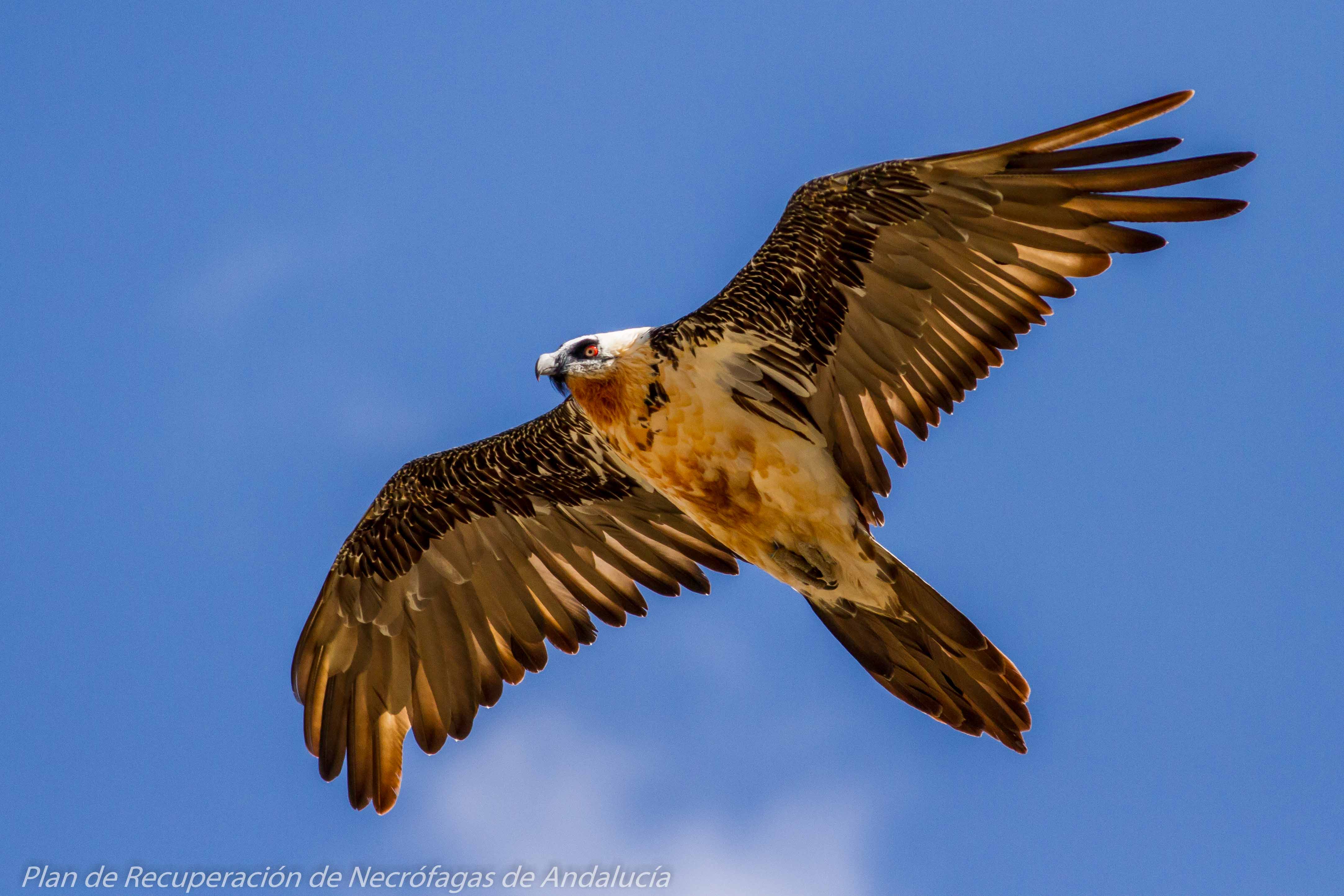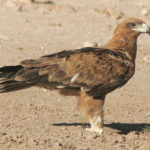Interview with Jose Rafael Garrido about raptor conservation in North Africa
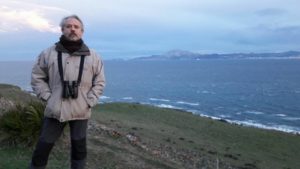
What is known about the historic distribution of the Spanish Imperial Eagle in North Africa?
The original breeding range of the species included the Iberian Peninsula and Northern Morocco and Algeria. However, today it is only breeding in Spain and Portugal. The species had bred in the North Morocco until the first half of the 20th century, with only two breeding records later in 1991 and 1995. It was also cited as a breeder in Algeria in the 19th century. The reasons of extinction in Morocco were both the increase of human persecution of all predators during 20th century and the increase of human population throughout territory. The species had its optimal habitat in the Atlantic Mamora Forest in Morocco, Mediterranean forest similar to Iberian habitat of species, and where low human population density allowed even the existence of leopards until at least the 1920s. Anyway, the species had in North Africa their southern limit of distribution and it was never very abundant. The North African population would have survived from immigrants from Spain but when the Spanish population almost become extinct during the 20th century, because of human prosecution, the African population was condemned to become extinct.
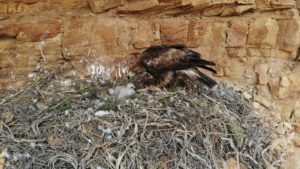
Later, the species was considered a vagrant until the first decade of the 2000s, but some eagles had been observed before near the Strait of Gibraltar and in Eastern and Northern Atlantic Morocco. However, from 2008 on, the regular crossing of young individuals every year has increased through monitoring of the migration in the Strait both in Morocco and in Spain. Additionally, dispersion and overwintering of the Spanish Imperial Eagles in North Africa was becoming regular and numbers increased because of the increasing of Iberian breeding population, with a regular presence in North Western Sahara at least since 2006, especially between Guelmin and Tantan in Morocco. Prior to this date there were many observations in these same areas of eagles that could be Spanish Imperial Eagles or Tawny Eagles, but in my opinion they were Imperial Eagles. The young of both species are very similar and even the young of Spanish Imperial Eagle is difficult to differentiate from the adult of Tawny Eagle. However, the last one is very rare in North Africa and the experience in recent years indicates that Guelmin-Tantan area is regularly visited by Spanish Imperial Eagles without any recent observations of Tawny Eagle. So, I believe that young Iberian Imperial Eagles have been visiting Morocco ever since, wintering in Guelmin-Tantan because of the high periodic abundance of prey, Fat Sand Rats, which has a similar size of young rabbits, one of the main prey species of Imperial Eagles, and also Barbary ground squirrel. Obviously, when the Iberian population was almost extinct in the 20th century, very few specimens crossed to Africa, but with the increase of the Spanish population in the last 15 years, it has also lead to an increase in birds crossing to Morocco.
But they do not just occur in this area. I am currently working as Coordinator of the Spanish Imperial Eagle Action Plan of the Regional Government of Andalucía (South Spain), in close collaboration with the Spanish National Research Council (CSIC) and the Migres Foundation. We have tagged about 30 younger eagles with GPS-GSM transmitters from 2015 and eight eleven of them dispersed to North Africa. The tags have shown that the eagles moved in the last four years through all of Morocco, including the North, Middle and High Atlas, Anti Atlas, Atlantic coast, Sahara, Eastern provinces and even Western Algeria and Mauritania. However, they were searching good feeding areas, which are not so abundant, so they only settled in very few sites, including the mentioned area of Guelmin-Tantan and some hunting reserves in Western Morocco where the eagles found enough prey. The interesting thing is that although most of the eagles returned to Spain within less than a year, we have data of birds with two and three years of age in Morocco, when they could already breed.
In addition to these observations the species has also been observed in the second half of 20th century in the Western and Northern Algeria, Libya and Senegal.
What is the current status of the Spanish Imperial Eagle in Spain and Portugal and is there a chance that it will start nesting in North Africa again?
The species breeds in the Centre, West and South of the Iberian Peninsula and is currently increasing both in Spain and Portugal, where the species has returned as breeder in 2002 after nearly 30 years of absence.
The history of the recovery of the Spanish Imperial Eagle is a success story worthy of mentioning with honors in the management books of endangered species. In the 1960s of 20th century only 50 breeding couples were estimated with a reduced distribution, which in the mid-nineteenth century included the entire peninsula except the North, while by 1970 the species took refuge only in remote areas of Southwestern Spain. So, it was on the verge of extinction because the human persecution and the decline of rabbit populations due to the appearance of man-made diseases to reduce damage of rabbits to agriculture. And finally, from the mid-sixties on, the economic and social development which took off in Spain, increased the electrification of the territory, which added to the already critical situation a new and serious conservation problem. The design of the poles of the electrical lines caused the electrocution of the birds that perched on them. So, although the breeding population survived in wild areas of large farms in remote mountain ranges, the young eagles left their native territory to disperse to areas with high density of food until reaching reproductive age. These areas use to be flat areas with little trees where the electric poles are the only perch sites to raptors. These poles can be a trap for Imperial Eagles because they can be seriously harmful to an individual which mistakenly perceives it as a suitable perch and is not capable of learning to selectively avoid it since almost all electrocutions are fatal and the eagle does not acquire experience to avoid them.
This dramatic situation began to change from 1970 on because societal awareness and pressure of the international scientific and conservationist community. The species was legally protected in 1973 in Spain, declaring its persecution illegal. This was also the beginning of monitoring and research programs. The knowledge of the conservation problems and the increasing of funding allowed designing conservation strategies against electrocutions and the recovery of rabbit’s populations. These active management measures increased both the population and its area of distribution, reaching up to 200 pairs at the end of the century. It is from beginning of the 21st century when the real take off of the species started, with an annual rate of increase of more than five percent, with currently about 700 pairs.
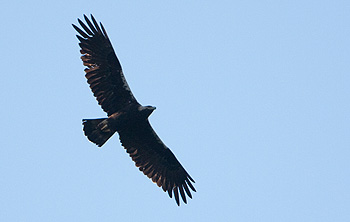
© Markus Jais
Speaking about my work on the Action Plan in Andalusia, we have got to increase the population from 30 breeding pairs at the beginning of the 21th century to 116 in 2019, exceeding the limit of 100 pairs in the region, which is considered the minimum population size in order to achieve a favorable conservation status following the criteria set by the ‘European Union Birds Directive’. This increase is largely related to the decrease in mortality due to direct persecution and, especially due to electrocutions. Retrofitting of thousands of dangerous electric poles and the implementation of specific legislation for the adaptation of power lines reduced the mortality of the Imperial Eagles by nearly 80%, particularly young dispersing eagles which have been incorporated into the breeding population. There has also been a continuous increase in the distribution area, recolonizing large areas in the East, North and Central Andalusia in recent years, where the eagle had disappeared more than 80 years ago. We also have got the colonization of a new breeding area in Cádiz, near the Strait of Gibraltar, through a successful reintroduction program. Today, after the release of more 100 juveniles since 2002, the success of the reintroductions is confirmed, with five breeding pairs formed in 2019. This population is still being reinforced with the release of chicks rescued from the field through the ‘hacking’ technique and it has a visible effect as a connector: there are already at least six individuals released in the reintroduction program that have joined the breeding nucleus in other areas of Spain and Portugal and it is the source of the most of watched individuals in Morocco.
As a result of the population increase in Andalusia and the Iberian Peninsula an increasing number of immature Spanish Imperial Eagles is visiting Morocco, so there is hope for the re-establishment of a Moroccan breeding population, similar to as it has happened in other areas of Spain and Portugal. Also, as I have said before, we have data of eagles in reproductive age in Morocco. However, recolonizing can only be successful if we can reduce threats like electrocution, low prey density and human prosecution and disturbance (which are common to all big raptors) not only in breeding potential areas but also dispersing areas, like protected hunting reserves in the Northern Morocco and the Guelmin-Tantan region.
What is known about the Tawny Eagle in North Africa?
North African Tawny Eagles belong to the subspecies Aquila rapax belisarius, which is endemic to this area. It is separated from the more widespread subspecies Aquila rapax rapax from Sub-Saharan Africa. It occurred in Morocco, Algeria and Tunisia until the second half of 20th century.
However, the species has plummeted through North Africa during 20th century because poaching, hunting and above all poisoning of all predators. Its scavenging behavior makes it vulnerable to farmers using poison for predator control. So, the Tawny Eagle is in the verge of extinction today. Rapid declines have been also reported from across all its African range.
In Morocco the species bred throughout the non desert country and dispersed through all North and Central Morocco. However, there have been no known breeding pairs since more than three decades. The last known nests were in Argan trees in open areas of the Souss, Western High Atlas and Anti-Atlas in 1992. Many ornithologists have been searching it at South Morocco and from 15 years to now there are no reliable data about it. I am working with Spanish Imperial Eagle monitoring tagged eagles and through field surveys in the area of Tawny Eagles in the country without any sightings. So the Tawny Eagle is now very rare and it is possible that last few records in Morocco could be mistaken with similar young Spanish Imperial Eagles, which are dispersing to Morocco, West Algeria and the Sahara desert as I said above.
In Algeria the species was also common, but the last breeding record was in 1990. However, there are recent observations from North African subspecies both North East and North West in 2018, so the species can still be breeding in some isolated places, maybe in the Parc Culturel de l’Atlas Saharien where it has been observed sometimes.
In Tunisia the population was apparently extirpated during first half of 20th century and without records in recent years.
Finally, there are some more recent winter records in the last years from the Sahara, but they are probably vagrant birds from Sub-Saharan populations of the subspecies Aquila rapax rapax.
What is the status of the Bonelli’s Eagle in North Africa?
Bonelli’s Eagle is the most abundant big eagle in North Africa, just like in Southern Europe, because it is a characteristic raptor of Mediterranean environments. The North African population is the biggest one of Mediterranean region. The species is well established in the Maghreb’s with approximately 2,000 breeding pairs, although the lack of census and monitoring programs does not allow us to have reliable information about the real size of the population. Anyway, Morocco could have 1,000 pairs all over the country to North Sahara, Algeria 200 breeding pairs and Tunisia about 50. The species is also present but very rare in Libya and Egypt, with very few recent records.
Dispersing and wintering eagles can be watched all over North Africa, even in Sahara, Mauritania and Senegal, but it especially concentrates high prey density areas like protected hunting reserves in the Northern Morocco and the Guelmin-Tantan region in Northern Moroccan Sahara.
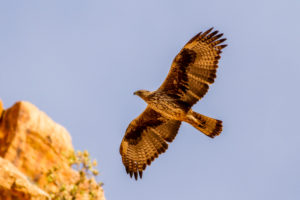
© Iñigo_Fajardo
However, like other big raptors Bonelli’s Eagles populations also suffered a decline in the second half of 20th century when the species was more common in all Maghreb. An increasing human population also caused increasing habitat destruction like building new infrastructures. Human disturbance during the breeding period, shooting and, recently, electrocution in power lines are additional problems. So, since 2016 we have found almost 50 adult and young electrocuted Bonelli’s Eagles in the Guelmim region, a very important area to big eagles from Europe and Morocco, which could be affecting the dynamics and conservation of Moroccan, and possibly European, populations of the species.
Anyway, it could survive better that other raptors the strong decline of last century because it tolerates more human presence. It is less vulnerable to poisoning since it almost never feeds on carrion and it hunts a wide range of prey like rodents, birds, reptiles, etc. Also, it can occupy, as a refuge, very steep areas with little human presence, occurring up to 2000 m in NW Africa.
How are vultures doing?
They are doing badly, as in the rest of Africa. There were five vulture species breeding in North Africa, mainly in the Maghreb: Egyptian Vulture, Griffon Vulture, Bearded Vulture, Cinereous Vulture and Lappet-faced Vulture, but the last two species were extirpated in the last century (although the Cinereous Vulture is a regular wintering and migrant in Morocco). Also, North African breeding vultures have seen drastic declines, with local extinctions, mainly because of poisoning during the 20th century, but also because of changes in food availability and human disturbance. Vultures in North Africa, through their scavenging habits, use to be unintended victims of poisoning because conflicts between humans and carnivores as jackals, wolves or feral dogs. In fact, in many countries like Morocco poisoning was even conducted by the government until end 20th century. Also, in this area vultures are almost entirely dependent on livestock carcasses due to the almost complete absence of wild ungulates over much of their range. And though livestock is very abundant, especially in Morocco, local traditions such as the burial of domestic ungulates carcasses decrease food availability to scavengers.
The Egyptian Vulture is the most widespread species. Though it still occurs Morocco, Tunisia, Algeria, Libya and Egypt, formerly the species was more widely distributed and the population is probably decreasing. But as we said before, there are no monitoring programs to confirm it, but it is known that it has disappeared from many areas over the last 50 years. In Morocco, Tunisia, and probably Libya, it has decreased to the point of nearing local extinction, even when in Morocco there were an estimated 500 breeding pairs in 1980s. It’s only still common in areas of Algeria and Egypt, but less widespread than 50 years ago. The recent discovery of an unknown new small breeding population in the Middle Atlas in Morocco give us hopes that the species will still be in other not yet surveyed areas of North Africa. Also, poisoning and hunting of Egyptian Vultures to use them in traditional medicine has been cited as another threat. However, you can watch more of 4,000 European Egyptian Vultures crossing the Strait of Gibraltar during migration.
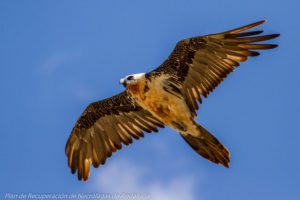
© Iñigo Fajardo
On the other hand, the Bearded Vulture inhabited in the recent past all high mountains in Morocco, Algeria and Tunisia, but now there are only isolated populations in the Moroccan High Atlas and Algeria, but less than 10 breeding pairs. However, as with Egyptian Vulture, a small breeding population has been discovered in the Theniet El Had National Park in Algeria, so it is possible that other populations could exist in remote areas. Anyway, this small population is isolated from other populations in Europe and Africa and it could in the midterm suffer a reduction in genetic diversity which could reduce chances of its survival. Local problems are poisoning and human disturbance, like uncontrolled trekking, cliff climbing and a ski lift near breeding territories.
Finally, the Griffon Vulture has been extirpated mainly by poisoning during the 20th century in all North Africa except Algeria, where the species breeds in the North East with at least 100 pairs. In Morocco I led a field survey searching nesting and wintering Griffon Vultures in 2002 and at least since then species has been extinct, though in 1980s there were still several breeding colonies in the country. However, it occurs in large numbers during migration in Morocco through the Strait of Gibraltar from and to Europe, without wintering populations.
As for the two extinct species, Cinereous and Lappet-Faced Vultures, I think it is interesting to note that both were breeding in trees, being therefore more sensitive to direct persecution, disturbance and habitat destruction by human use of forest resources because of an increasing human population. North African birdwatchers are very lucky as they can still watch vagrants of both species.
It is also interesting that a Sub Saharan species, Rüppell’s Vulture, is increasingly watched crossing the Strait of Gibraltar, which could be important because the species has experienced extremely rapid declines in much of its range where it is Critical Endangered.
What are the main threats to raptors in North Africa?
The same threats faced in the rest of the world: the growth of the human population and associated conflicts with wildlife. It is known that in all of North Africa illegal killing is very important, with known episodes of shooting eagles and vultures in Morocco, Tunisia, Libya and Egypt at least. Unintended poisoning, even conducted by the government, was the main reason of extirpation of raptors in the 20th century, mainly vultures and probably Tawny Eagles, because persecution of livestock predators such as jackals, wolf, feral dogs or leopards. But it could be important even now, at least locally. On the other hand, in some places Golden Eagles have been killed by poisoning and shooting because they hunted lambs when wild preys decreased and Egyptian Vultures are locally hunted to use them in traditional medicine. In this sense, I have watched raptor remains of vultures and Booted Eagles in local markets of Morocco. And in some of these markets it is still common to find many big and small raptors captured for exhibition and sale.
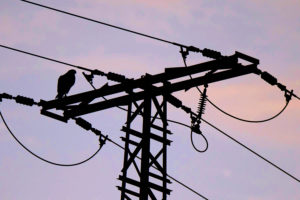
© Jose Rafael Garrido
The increase of the human population has also produced habitat destruction, especially of forests because use of wood collected as fuel for cooking and heating and for logging, deforestation and clearance of large trees to increase crops and feeding areas to livestock. And many people also mean decreasing of wild ungulates and other preys because they are hunted for food which leads to a reduced prey base and a reduction in raptor numbers. This is especially important to vultures because though wild ungulates have been replaced by livestock, as I said you before, local traditions such as the burial of domestic ungulate carcasses make them unavailable to vultures. With many people also comes the fragmentation of habitats due to the increase of roads, constructions, dams, power lines, etc. And so, electrocution is also a big problem. In South West Morocco, we found a 24 km power line which is the main known black spot of non-natural mortality of raptors in Maghreb killing big eagles as Spanish Imperial Eagles, Bonelli’s Eagles and Golden Eagles, but also Long-Legged Buzzards, Peregrines and Lanner Falcons and Pharaoh Owls. But I am sure the problem is more widespread throughout the area threatening even the rare Egyptian Vultures, as it has been found in Spain and Sudan. Where we look for electrocutions we always find them, which is even more important because in the last 30 years there has been electrification of the territory without measures to protect birds perching on poles as raptor are. This problem could be limiting the chances of recolonization of Morocco by Spanish Imperial Eagles and the recovery of breeding populations of the other big eagles.
Probably, collisions with power lines are also a big problem, as in other areas of the world, but the lack of survey and monitoring programs prevents us from knowing it. In the same way, the planned increase of massive wind energy projects, especially in North Morocco, could kill thousands of raptors and endanger some local populations as it has happened in South Europe for Griffon and Egyptian Vultures and in South Africa for Bearded and Cape Vultures.
Another threat is human disturbance because of uncontrolled trekking, cliff climbing and ski lifts, which have been related to breeding failure of the highly endangered Bearded Vulture.
Finally, the very small size and isolation of breeding populations of some species such as Tawny Eagles, Bearded and Egyptian Vultures are a very important threat because of endogamic problems which could decrease breeding rates and lead to extinction. These populations would only survive through immigration of other populations, but there are no viable populations nearby. That would have been the final cause of the extinction of the last Cinereous and Lappet-Faced Vultures, Spanish Imperial Eagles and Dark Chanting Goshawks, which has disappeared from its only breeding area in South Morocco in the last 30 years.
How does the public see raptors in North Africa?
People in North Africa have more immediate problems to solve than biodiversity conservation according to their point of view. Poverty and lack of medical attention and education are their main worries, so raptors are not important, except if they could be a problem hunting their livestock or if they could be a source of money. In this context, the challenge is to protect raptors in view of the needs and aspirations of the growing human population. Poverty, particularly in the rural areas, means that local populations remain heavily reliant on natural resources from the forests for their subsistence. That’s not to mention the violent conflicts, which devastate livelihoods, socio-economic development and natural resource protection. But even when livelihoods improve, local human population also put pressure on biodiversity because of habitat transformation and a lack of awareness in biodiversity conservation.
And though all countries have specific legislation to protect raptors, the lack of general awareness about the importance of conserving them makes it hard implement raptor conservation actions. For example, despite knowing the problem of electrocution for years and the solutions to be adopted, mitigation work has not yet been carried out, despite having the money to do so.
However, I am optimistic, because some things are changing. From Morocco to Egypt civil society has organized to influence governments to conserve nature, including raptors and their habitats. A lot of environmental NGOs have grown in the last ten years and they are pressing to protect and recover raptors populations. It’s still early, but local partners of BirdLife International, as GREPOM in Morocco or Association Les Amis des Oiseaux (AAO) in Tunisia, other environmental groups like GOMAC and the Association Marocaine pour la Fauconnerie et la Conservation des Rapaces in Morocco or The Algerian National Association of Ornithology (ANAO) in Algeria, and many more, are doing a very good work increasing knowledge and awareness of raptors, and other birds and their conservation.
We cannot forget the role of scientists and universities in North Africa, with very good researchers, as well as some management practitioners which are working hard to preserve wildlife almost without resources.
What can be done to reduce problems for raptors in North Africa?
The first action should be to build capacity for conservation actions through developing knowledge and monitoring of birds of prey with two main objectives. On the one hand, the location of breeding, dispersing and wintering sites allows focusing and prioritizing conservation actions. And on the other hand, monitoring of populations and their threats allows knowing geographic and demographic trends and designing specific conservation action plans. Measures should also be taken to prevent habitat destruction, especially in the case of the construction of linear infrastructures, which are fragmenting territories and could increase human disturbance, through good environmental impact studies and/or mitigation projects. The same can be said for building of dams, wind farms (which especially kill a lot of vultures around the world), solar energy plants and power lines. In this sense, though there are environmental laws and protected areas as National Parks, there is not enough awareness and there aren’t enough resources to enforce them. I think, the creation of a new National Park in SW of Morocco between Guelmin and Tantan would help to protect breeding, dispersing and wintering raptors. This is a very interesting ecological region unique in North Africa not only for raptors, but also other birds, plants, invertebrates, reptiles, etc.
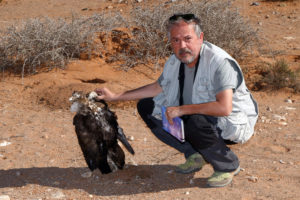
© Daniel Buron
Also, human disturbance must be controlled around breeding sites, including the expansion of tourism and associated infrastructures, which is very important to avoid breeding failure of the highly endangered Bearded Vulture. It would be good to enforce rangers to look out for nests during breeding season.
Obviously, attention should also be paid to the impact of illegal killing, capturing of individuals for exhibition and sale and poisoning through implementation and reinforcement of environmental policy and awareness campaigns for the civil society. For that, it is necessary to build capacity among stakeholders about mitigation actions for power lines and techniques of police investigation of crimes against raptors, especially poaching and poisoning. Key stakeholders are national and local NGOs, environmental administrations, the police and rangers, universities and also power lines companies which are responsible for minimizing mortality through electrocution and collision. In Spain and South Africa big companies are working together to protect raptors and other birds and it should be exported to North Africa. Today there is still no agreement of this kind in any country in North Africa and only by working together can we recover species like the Spanish Imperial Eagle in Africa. It would be good if people both from professional and civil society will survey power lines in breeding and wintering areas of raptors to detect new blacks spots of raptor mortality and made them public. It could help to inform the electricity companies and administrations to take action in effective planning, design and mitigating measures which could dramatically reduce the impact of energy infrastructure on raptors populations.
But only if North African people want to, will it be possible to conserve the magnificent eagles and vultures. It is essential to empower environmental leaders to influence the awareness of their societies for the protection not only of raptors but of all biodiversity. And to that it is also necessary to get funds and support of international institutions and to reduce poverty through sustainable development like birdwatching or other wildlife tourism.
To conserve vultures there is an international Multi-species action plan to conserve African-Eurasian vultures from Convention on the Conservation of Migratory Species of Wild Animals, which should also be implemented in North Africa, including fighting against and raising awareness of poisoning, illegal killing as well as improving supplementary feeding. North Africa, especially Morocco and Algeria, could be a very good place according to nest sites available to vultures if we could increase food availability and decrease direct and indirect human persecution. Food shortage could be solved through the provision of food in vulture restaurants and the establishment of good practices in the local livestock farms. And in the future, if threats are controlled it could be possible to implement reintroduction programs as they have been successfully developed in Europe with Griffon and Bearded Vultures. The same thing could be done with the Spanish Imperial Eagle in good hunting reserves of Morocco, but only if the problems are solved previously, especially electrocution along power lines.
What projects are you working on in North Africa?
I began to work in conservation of raptors, and other birds, in Morocco more than 20 year ago. It was in the summer of 1999 when I was part of the first team that started to monitor the migration of birds through the Strait of Gibraltar from the Moroccan side. I discovered a hospitable people like no other and a first gateway to the continent that every naturalist dreams to visit. So, like the first love, Morocco was, is and will be one of the places that will always fill my heart. Since then I have not stopped unraveling some of the many mysteries that this great country still treasures with Moroccan good friends as Nourdine, Rachid, Ali, Brahim or Karim. From them until now I traveled through the mountains of the Rif and the South and the Eastern desert searching for breeding colonies and roosting sites of Griffon Vultures; the central countryside tracing the last African Great Bustards; the High Atlas and Anti Atlas Mountains monitoring the last North African Bearded Vultures and, more recently, the wide cork oak forest and the Southern deserts looking for Spanish Imperial Eagles.
At the present, as coordinator of monitoring and conservation programs of raptors and the Spanish Imperial Eagle Action Plan to the Regional Government of Andalucia, the most southern autonomous community in mainland Spain, I have been working with the IUCN Mediterranean Cooperation Center (IUCN-Med) to develop knowledge transfer activities related to the conservation of threatened raptor between technicians and managers from both shores of the Mediterranean. Among other activities, we have organized an international meeting aimed to engage North African and Spanish stakeholders on trans-boundary conservation of threatened raptors (Spain, 2015), a regional workshop on identification of the impact of electric infrastructures on birds and other threats like poisoning (Spain, 2016) and two national capacity building workshops on the same issue in Tunisia (2017) and in Morocco (2018). Following the recommendations from those workshops, we are implementing a series of actions leading to minimize the impact of power line mortality on raptors in Morocco. So, I carried out a field survey identifying a “black spot” for raptor electrocution in Southern Morocco in 2016 coordinating a team of Spanish and Moroccan environmentalists from GREPOM, IUCN-Med and my government, to identify and locate pylons dangerous to birds, especially raptors. We located hundred of dangerous pylons and near 80 electrocuted birds, especially large eagles, including at least four Spanish Imperial Eagles and 40 Bonelli’s Eagles. We wrote our results in the report Identification de la mortalité des rapaces par électrocution dans le sud-ouest du Maroc from IUCN-Med, which was presented at IUCN World Congress of Hawaii in 2016, and in the communication No Pole Design without Effective Mitigation Techniques is Safe for Raptors in Morocco to the Raptor Research Foundation 2018 Symposia: Conservation and Management of Raptors on Overhead Electric Systems, organized in South Africa. Also, from my government and with Migres Foundation of Spain, we have capacitated ornithologists from the Association Marocaine pour la Fauconnerie et la Conservation des Rapaces to tag raptors with satellite transmitter, including Bonelli’s Eagles and even a Spanish Imperial Eagle recovered in Morocco by this association. The eagle was fitted with a GPS transmitter and marked with a yellow PVC ring ‘M06’ and it was successfully released on 17 December 2018 near Rabat. Sadly, more than 2000 kilometers and a month later, on 15/01/2019, M06 was found dead in the Sahara desert.
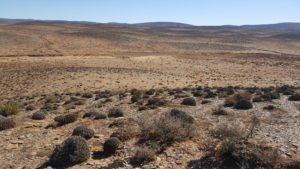
© Jose Rafael Garrido
In addition, we have developed a handbook for the identification of dangerous power lines for birds in North Africa, a mobile application to monitor dangerous power lines and a Data Base on bird electrocution events in Morocco, as well as a mapping exercise on areas of electrocution risk for birds in Morocco, all tools to improve spatial planning and retrofitting actions on power lines to advance in raptor conservation. Our goal is that these tools will be useful to conservationists of not only all of North Africa, but also other areas of the world. In this context, in March 2019 we presented to the African Conference of Linear Infrastructures and Ecology in South Africa the communication The value of knowledge transfer to reduce raptor mortality due to power lines in North Africa, which states the importance of the knowledge transfer from Europe to Africa to solve problems of conservation in raptors and other birds.
These works are not only useful to conserve North African raptors, because our work with Spanish Imperial Eagle using satellite telemetry, and other ones with Bonellí’s Eagles, have shown the big movements of Spanish eagles between Spain and North Africa. The same thing happens with migratory Griffon and Egyptian Vultures, so accordingly, conservation actions can only be effective if implemented at the flyway level, which requires a broad approach and the engagement of all Range States.
I am also working with IUCN-Med and the High Commission for Water, Forests and the Fight against Desertification (HCEFLCD), the environmental agency of Moroccan government, developing a monitoring program (the Atlas Program) of breeding populations of cliff raptors in the country. The objectives of this program are to conduct an initial inventory of diurnal cliff-nesting raptors in Morocco, to monitor their demographic and geographical evolution, as well as to identify threats that may negatively affect them. So, this year I have coordinated two teams of Spanish and Moroccan ornithologists to survey West and East dessert areas of the country searching cliff nesting raptors such as Golden and Bonelli’s Eagles, Lanner Falcons, Peregrines and Barbary Falcons and North African or Long-Legged Buzzards.
How can bird watchers help protected raptors in North Africa?
There is little knowledge about the distribution and abundance of raptors in this region and any help is necessary. So, the information about any observation of these species is very useful to map their distribution area, whether they are wintering or breeding populations. Bird watchers are a very good chance to fill this knowledge gap, because they can move through wider territories collecting a lot of useful data to monitor a broad range of species over long time periods and broad spatial extents, which can generate information on species population trends. They also can take part in censuses of raptors populations and migratory patterns, even assisting in identifying threats, as locating deadly power lines or poisoning events. Today, observations of bird watchers through the entire world are available at digital platforms and mobile app such as eBird, Observados and the African Raptor Databank.
On the other hand, if it is well managed and enhanced, bird watching can also be one of the best sources of ecotourism income since bird watchers are the largest single group of ecotourists (they have above average incomes). Birdwacthing should be promoted to provide sustainable economic resources to North African people helping to reduce poverty through conservation of nature. Morocco has some good examples of this activity, being a desirable destination for European birders.
What was your most amazing experience with raptors?
I have had several great experiences, some of them in North Africa. I can remember the observation of some of the few breeding pairs of Bearded Vultures fighting with Golden Eagles in the skies of the High Atlas Mountains or watching the migration of thousand of European Honey Buzzards, Egyptian and Griffon vultures, Booted and Short-Toed Eagles through the Straits of Gibraltar. In the same way, the first flights in freedom of the Spanish Imperial Eagles reintroduced in Andalucia always excite me, so do the adults of this species adopting and carefully feeding fledglings rescued from other nests with problems. But undoubtedly who has surprised me the most is Bonelli’s Eagle. There are two experiences that still make my skin crawl when I remember them. One was the observation of the cooperative hunting of a breeding pair. Both eagles acted perfectly coordinated and while the male flew directly and scared a group of Cattle Egrets, the female, who was flying higher, threw herself with her wings closed against the group catching one of the egrets without great difficulty. And the other occasion was when I watched a female trying to get its fledgling to leave the nest for the first time. She flew around the nest showing it a large lizard that she had hunted and perched a few dozen meters from where she called it. She behaved so several times, but after more than half an hour, seeing that the young eagle had no intention of flying, she desisted in her efforts and left the prey in the nest. It seems that we are not the only ones who find it hard to leave home when we grow older …

